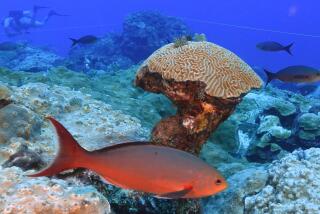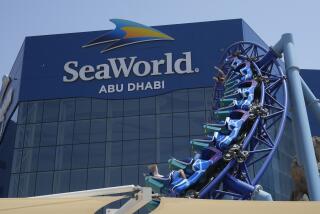EXPLORING THE REEF
- Share via
GLADSTONE, Australia — It begins just south of New Guinea, Australia’s Great Barrier Reef--the mightiest structure ever created in the ocean, a coral wall nearly equal to the distance between New York and Miami, a travel attraction without match.--JERRY HULSE, Times Travel Editor
The traveler who voyages from familiar surroundings in search of remote and exotic cultures is most often in search of a mental and emotional jolt, a rekindling of passionate curiosity, an encounter with something strange and powerful enough to leave him slightly disoriented, comfortably high.
Trouble is, that kind of voyage is usually accompanied by smelly outhouses, insect bites, tinned meat and sticky gruel. And the only way to get there is usually over a muddy road or on an airplane held together by rubber bands.
There is, however, an adventure trip perfectly suited to the timid and cautious, a journey to a realm so alien to man that its creatures are finally unknowable, a voyage powerful enough to suspend all frets and worries about the minor details of life back home. All it takes to get there is an airplane ride and a helicopter hop to a fantastic tropical island resort.
The Great Barrier Reef off Australia is, many say, the most splendid ecological niche on earth. Certainly it is a bizarre and fascinating world, crowded with life, wildly colorful and rich in both drama and design. To see it you have only to get out of bed, walk down to the water’s edge, put on a face mask and float. You can explore the strange world of a coral reef without guides, and without porters bearing stoves, showers and cases of mosquito repellent.
Live coral reefs are in the Caribbean, the Red Sea, the South Pacific and off the Maldive Islands, Mexico and Belize. But the Great Barrier Reef is probably the best of all reefs to explore with a snorkel.
It is a wonder of the world: 1,250 miles long, 2 million years old, the largest structure ever built by living creatures. If it were off the coast of the United States it would stretch from Seattle to Baja. And for miles on end, it lies under only a few feet of warm, clear water.
Divers talk about the ecstasy of the deep, but snorkelers have similar tales of overwhelming wonder and awe. Underwater, certain artistic and philosophical conundrums become instantly clear. For one thing, there is nothing new under the sun, no color combination created by man that was not first created by nature underwater, no patterns or designs that were not drawn on this primitive landscape long before prehistoric people made scratchings inside a cave.
Even though you may have seen tropical fish in aquariums, the number and variety of those that feed off a coral reef are mind-boggling. Schools of fish move by so fast that you’d swear they were on some kind of laser track. Hundreds of tiny, iridescent fish drift with the current, so sweetly that you can swim right along with them.
Stingrays float along the ocean floor, clown fish hide in the arms of sea anemones, crayfish poke out from under rocks. Striped red-and-yellow fish with spots of purple and lapis lazuli nibble contentedly at the seaweed.
But fish are less than half of the snorkeling experience. The coral gardens come in all colors, shapes and sizes; some hard, some leathery, some soft, like seaweed. Canyons and gorges and forests of coral, purple-tipped coral, coral covered with sponges and tunicates, coral encrusted with tube worms.
A truly dedicated reef explorer might hire a boat and explore its far edges, hundreds of miles off the Australian coast where the water is so clear that you can see as far as 200 feet. But the less ambitious or less affluent tourist can either take day trips by boat out to the reef from the mainland or stay on one of the three islands on the reef that have accommodations for tourists.
Lizard Island, on the northern part of the reef, is probably the best diving and snorkeling place. One small resort on the island is first-class. Film stars stay there during the marlin season.
Green Island close to the Australian coast, east of Cairns, is filled with day-trippers and fast-food stands.
Heron Island, on the southern part of the reef north of Brisbane, is only moderately expensive, and its resort is pleasant and relaxing.
I stayed at Heron Island because John McKerricher, head of the Steinhart Aquarium in San Francisco, recommended it. It is a sweet little place formed by sand settling in a calm place on the reef, and it has the advantage of being a national park. Being here is a little like being in the Galapagos Islands; thousands of birds and hundreds of turtles court, mate, build their nests, lay their eggs and feed their young here every year.
At times, even the resort treats tourists as less important than the animals. When baby turtles hatch at night, for instance, and must use the stars to guide them into the ocean, guests are required to turn off all lights in their rooms. During the muttonbird mating season the shop at the hotel sells earplugs for those who are disturbed by their incessant and pathetic squawks and groans.
Dormitory-style accommodations for divers and singles run $67 a day, including meals. Lunch and dinners are elaborate and delicious. Breakfast is, well, skip it anywhere Down Under unless you like white bread, canned spaghetti and limp, undercooked bacon. Private rooms with bath run $100 to $117 per person, including meals.
Most important, good snorkeling is right outside your room, and diving boats leave twice a day for the best spots on the edge of the reef.
Scientists refer to the Great Barrier Reef’s “high order of internal organization” which is, they say, even greater than that of a tropical rain forest. The reef receives large amounts of solar radiation, the ultimate source of all ecosystem energy, and has more species per square foot than anyplace on earth.
But there are many things to ponder while floating in warm tropical water, at zero gravity, in isolation, at the edge of this strange world. The animals are amazing, but the snorkeling experience is basically internal. It tends to inspire meditation.
Nothing really happens, while snorkeling, except a peaceful confrontation with life forms so silly that occasionally you have to break into a sort of muffled underwater laugh. Prejudices and certainties ebb and flow with the tide.
It’s the kind of voyage that turns into a Hans Christian Andersen tale about a sailor being tugged down into the sea by a mermaid.
For more information write to Heron Island Resort, Gladstone, Queensland, Australia. Australian Tourist Commission, 3550 Wilshire Blvd., Suite 1740, Los Angeles 90010, phone (213) 380-6060; Queensland Tourist & Travel Corp., same address, phone (213) 381-3062.
More to Read
Sign up for The Wild
We’ll help you find the best places to hike, bike and run, as well as the perfect silent spots for meditation and yoga.
You may occasionally receive promotional content from the Los Angeles Times.






